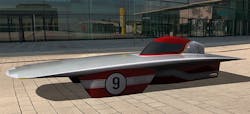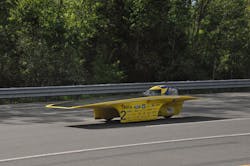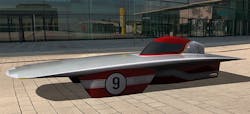While hybrid and electric cars grab a growing share of the automotive market, we’re still a long ways from seeing solar powered cars on our highways. Universities around the globe, though, are working on innovations that may bring them to your local showroom someday. And beginning this week, they will meet to put their creations to the test.
About 20 student teams will participate in the nation’s two biggest collegiate solar car races, the Formula Sun Grand Prix and the American Solar Challenge. Hosted by the Cockrell School of Engineering at the University of Texas at Austin, the competition features cars that can reach 40 to 50 mph using only 1200 W, or about two-thirds the power it takes to run a hair drier.
Teams will compete in the Formula Sun Grand Prix at the Circuit of the Americas (COTA) Formula One racetrack in Austin, July 14-19. The “scrutineering” will begin with qualifying events and inspections. Teams that pass muster then will compete in a three-day endurance race on the COTA track. The team that logs the most laps after the three-day racing period wins.
All of the teams that complete a minimum number of laps at minimum speed in the Grand Prix then will move on to the American Solar Challenge. From July 21 to July 28, these teams will attempt the more than 1700-mile drive from Austin to Saint Paul/Minneapolis, Minn., proving the reliability and endurance of their cars in real-world driving conditions. The fastest elapsed time for completing the route will win.
The 23 cars competing this year include the University of Kentucky’s Gato del Sol V, UC Berkeley’s Zephyr, UT Austin’s TexSun, the Netaji Subhas Institute of Technology’s Advay III, Polytechnique Montreal’s Esteban VII, Qazvin Islamic Asad’s Havin 2, ETS Quebec’s Eclipse 8, the Massachusetts Institute of Technology’s Valkyrie, Oregon State’s Phoenix, and Puerto Rico Mayaguez’s El Wanabi.
“During the team’s various testing events and competitions, our solar car is the star. As it drives by, other drivers rubberneck, pedestrians point, and cameras flash,” said Ian Sullivan of the University of Michigan Solar Car Team. The team’s Quantum weighs 145 kg and is powered by a 1500-W SunPower Mono-Si array with a 5-kWh lithium-ion (Li-ion) battery pack and a 1.8-kW CSIRO motor (Fig. 1).
“I’ve been working with the team ever since the first week of school. They pull you right in and you really just learn by experience. You can learn everything you need to do,” said Neal Dylan Neal, who designs parts for the PrISUm team from Iowa State University. PrISUm’s Phaeton weighs 180 kg and is powered by a 1200-W SunPower Moni-Si with a 4-kWh Li-ion battery pack and a 7.5-kW NGM SCM150 motor (Fig. 2).
“We are thrilled to host students and faculty from across the world as they participate in these competitions,” said Sharon L. Wood, interim dean of the Cockrell School of Engineering. “These races reinforce the skills and knowledge our engineering students gain throughout the year and offer them an exciting opportunity to design, build, and test their technologies.”


